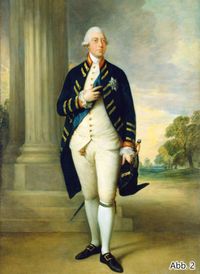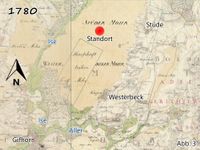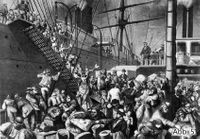Beggars, thieves and other crooks?
The foundation of the two villages Neudorf and Platendorf began in 1795 with an agreement between the first settlers and the absolute ruler, King George III of Hanover. The king anticipated a profit from his customs revenue from the peat. The peat could only be taken away by a canal running between the villages. This meant it had to pass his customs post. The map from 1780 (Fig. 3) shows the Royal Peat Bog of the day, on which the two villages were located.
Many of his subjects were fed up of living a life in poverty and without freedom, and they were inspired by the ideas of the French and American revolutions. They fled to America and fought against the king in Hanover, who was also the ruler of Great Britain, Ireland and the colonies at the time.
The king wanted land and to create local colonies to curb the exodus. The colonists hoped for an adequate life. Both were disappointed. Things did not turn out as planned. The colonists suffered from hunger and lived in great poverty. Every day was a struggle for survival. The king lost money.
Without the investment of the entire wealth of a private individual, the factory owner August Wegener, who built a glass factory in Triangel, the settlers would not have survived. August Wegener stood up for these people. In the worst possible hardship, and against much resistance, he managed to get the king to finance a soup kitchen. But to his great disappointment, the people in Neudorf-Platendorf were too proud to live on charity. They wanted justice.
Many examples of negative opinions expressed by officials from Gifhorn have been handed down. Only the official assessor Westfeld showed courage:
“The unending screams of the starving moor colonists in Platendorf and Neudorf has finally stirred the sympathy of soulful people…”. “…We have to help, but not by filling the mouths of the colonists and letting them starve to death. No, we have to allow them to earn their bread.”
The king even refused to allow relocation to Stüde. There was still no freedom of movement. The king decided everything.
Consequently, many settlers fled to Poland or America. In the area of today’s Gifhorn district, most of these, 44 families, came from Neudorf-Platendorf. Figure 5 shows a painting from 1850 on which German emigrants in Hamburg are boarding a steamer heading to New York.
From today's perspective, the settlement contracts were most undoubtedly unethical, if not plain criminal. Even then they did not comply with the sense of justice of compassionate people like August Wegener. Without the support of August Wegener and many others in the surrounding villages, the residents would have starved.
Figure 6 shows a map of Platendorf and Neudorf from 1793, drawn by Friedrich Findorff. He attached great importance to individual properties having the same size and shape to guarantee social and economic equality among the moor colonists.
Links to other stations in the museum - in English language:
<1> <2> <3> <4> <5> <6> <7> <8> <9> <10> <11> <12> <13> <14> <15> <16> <17> <18> <19> <20> <21> <22> <23>




